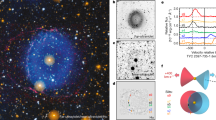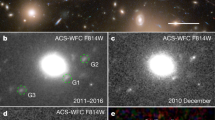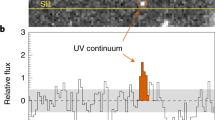Abstract
IN the system of cosmology I have advocated, and also in the parallel theory of Bondi and Gold, the nebulæ are not all of infinite age as Prof. R. O. Kapp seems to imagine. In a sufficiently large volume V cm.3 of space, the number of nebulæ with ages greater than T (T being measured in units of Hubble's constant, namely, 1.8 × 109 years) is about 10−72 V e−3T, the average spacing between nebulæ older than T being about 1024 eT cm. By taking V large enough, it is true that a nebula of arbitrarily large T can be found. But this has little interest when related to astronomical observation, for the effect of the red shift of light, arising from the expansion of the universe, is to make the observation of events occurring at distances greater than about 1.7 × 1027 cm. inherently impossible (even for an observer equipped with a perfect telescope). It follows, therefore, that tle oldest nebulæ within the observable portion of the universe have ages T given, so far as order of magnitude is concerned, by 1024 exp T = 1.7 × 1027, that is, T = 7.44 Hubble units = 1.34 × 1010 years. These nebulæ have been identified tentatively with the nebulæ in the great clusters. It may be noted in passing that a specially chosen observer can detect one condensation having an age T appreciably greater than the value given by the above equation. But the probability of this occurring for an observer taken at random decreases with increasing T according to the factor exp — 3T.
This is a preview of subscription content, access via your institution
Access options
Subscribe to this journal
Receive 51 print issues and online access
$199.00 per year
only $3.90 per issue
Buy this article
- Purchase on SpringerLink
- Instant access to full article PDF
Prices may be subject to local taxes which are calculated during checkout
Similar content being viewed by others
Author information
Authors and Affiliations
Rights and permissions
About this article
Cite this article
HOYLE, F. Development of the Universe. Nature 165, 68–69 (1950). https://doi.org/10.1038/165068b0
Issue date:
DOI: https://doi.org/10.1038/165068b0



